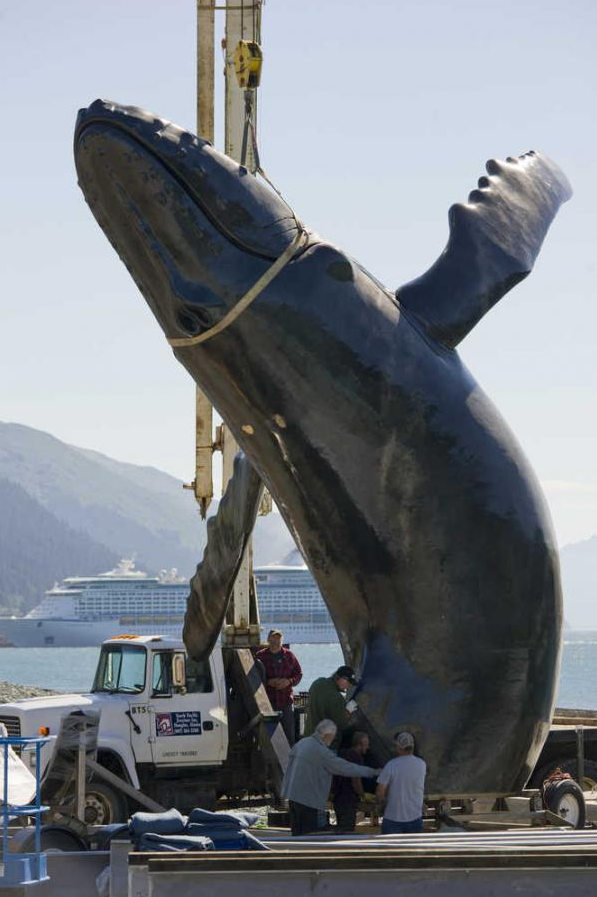In his Sept. 9 commentary, Win Gruening was right to criticize the Empire Readers’ Council (ERC) for speculating about the motives behind the head tax lawsuit filed against the City and Borough of Juneau. It’s up to a federal judge to decide the merits of the case. And unless the parties settle out of court, he won’t do that until attorneys for both sides have presented him with all their arguments and supporting evidence which we bystanders haven’t seen.
[Empire Readers’ Council: Head tax lawsuit nothing but hot air]
But back in April, Gruening was the one who brought the lawsuit into the court of public opinion. And he was first to suggest that the catalyst for it was plans to construct the seawalk, artificial island and park that will contain the bronze whale sculpture and reflection pool.
Cruise Lines International Association (CLIA) and its Alaska affiliate formerly filed their lawsuit in Federal Court on April 13. The ERC is correct in that it “challenges … the legality of taxes imposed as a condition of entry into City and Borough of Juneau … on passengers arriving in CBJ on cruise vessels.” And CLIA is seeking “a declaration that CBJ’s entry fees are unlawful and a permanent injunction against the assessment, collection, and improper use” of the head tax. Those quotes come directly from complaint filed with the court.
Gruening was amazingly quick to come to CLIA’s defense. At midnight the same day the suit was filed, his Empire commentary was posted online stating the “dispute has been simmering for years but the seawalk/island project simply went too far.” He concluded by saying both parties should work to resolve the issue quickly. In other words, he was calling on CBJ to negotiate a settlement instead of trying to defend itself in court.
Seven months before that, Gruening had already begun arguing CLIA’s case. He accused CBJ of funding many projects “with dubious connections to cruise ship impacts.” Referring to this project as an “island too far” he wrote “it stretches the imagination to see how creating a park with a sculpture — claiming future passengers will walk miles to see it — legally qualifies an island and connecting seawalk to receive $10 million in head tax funding.” He speculated CLIA might take legal action and rhetorically asked “who could blame them?”
The seawalk is not CLIA’s only complaint. They’ve accused CBJ of spending $22 million from the head tax collections for general government operating expenses during the past 15 years. If that’s true, and the money wasn’t earmarked to address the impacts of cruise ship tourism, it would be a clear breach of the tax law.
[Cruise ship group: Statue plans are misuse of fees]
At this point though, CBJ hasn’t responded to that or any other allegation. All it has done is ask the case be dismissed on the grounds that it doesn’t belong in federal court. And I’m not about to speculate on how it will proceed if the lawsuit does go forward.
So let’s get back to the seawalk and park. In their complaint, it’s the only example CLIA has given as an activity “unrelated to and/or which have not provided any benefits to passengers and vessels.” The issue isn’t the whale, John Binkley, the association’s president, told Juneau’s Chamber of Commerce the day after they sued the city. “It’s about a mile from the current docks,” he said, “and that’s really our concern.”
But do tourists want to be corralled inside the congested downtown shopping area? Or would they like a broad range of choices to help them escape those crowded city streets?
A place to look for the choices tourists make is the Mendenhall Glacier. The opportunities at Juneau’s number one attraction have expanded in recent years. Among the enhancements is the 0.9-mile trail to Nugget Falls.
According to John Neary, the Visitor Center’s Director, the trail is so popular that it’s changed how the tour bus companies operate. They now offer shuttles so people don’t have to return to the docks on the same group bus they arrived on. That allows them time to enjoy the Visitor Center and other short interpretative trails, plus go out to Nugget Falls, a walk that Neary estimates up to 3,000 people take each day.
Could that happen downtown?
In the end it won’t be the CLIA, a judge, project supporters or detractors who ultimately decide if the seawalk and park is too far from the docks. It’ll be the tourists. Some of them already walk the half mile uphill to see the state Capitol and Governor’s Mansion. And it won’t be long before we learn how many are willing to walk a mile along the shore to see a life-sized sculpture of a humpback whale.
—
Read more Opinion:
Letter: Future uses of the Alaska Court Plaza on Fourth and Main Streets

